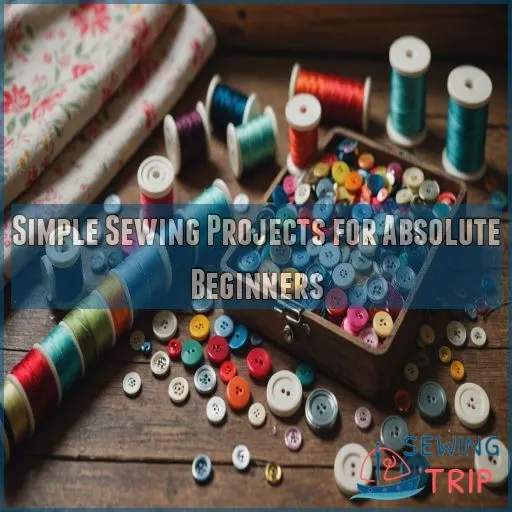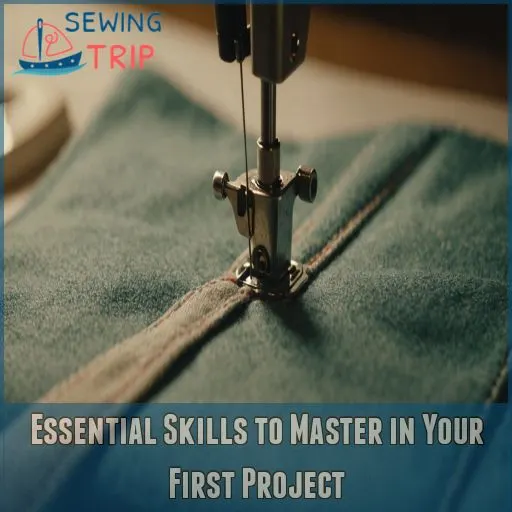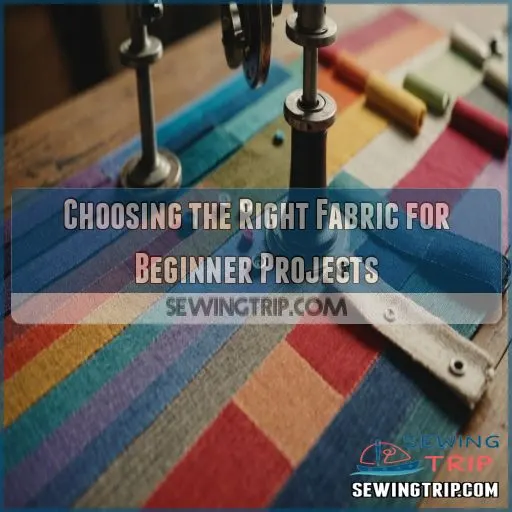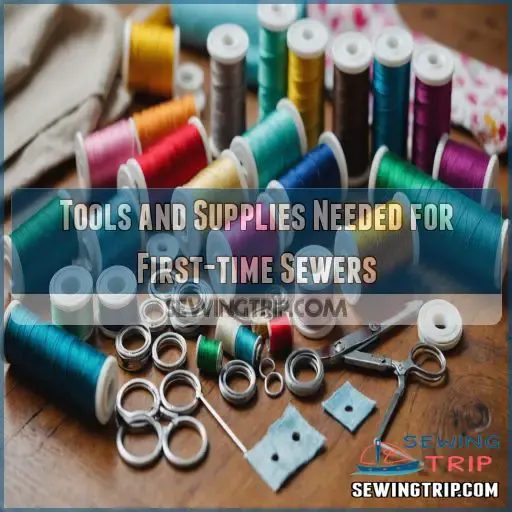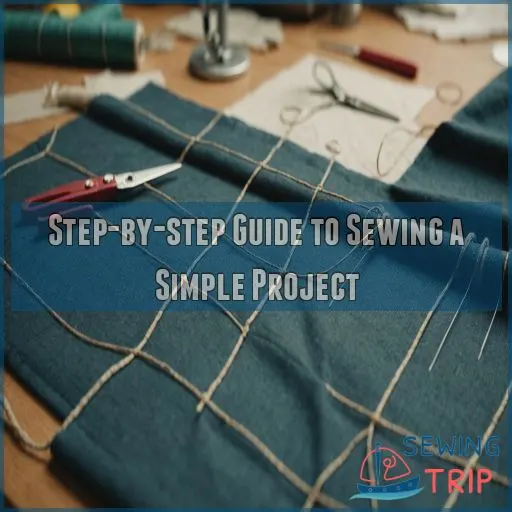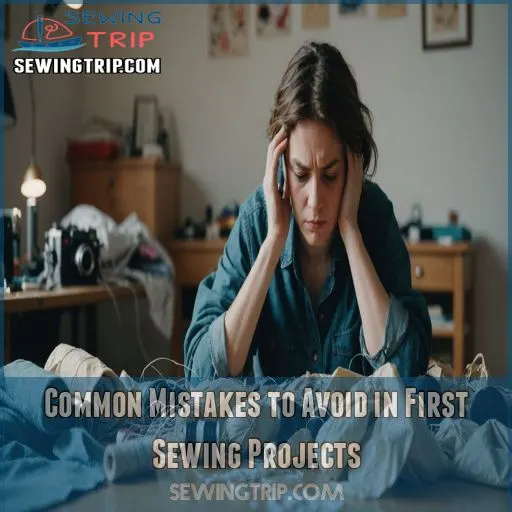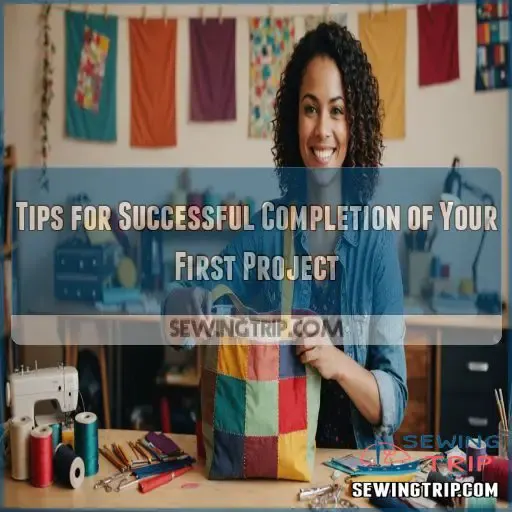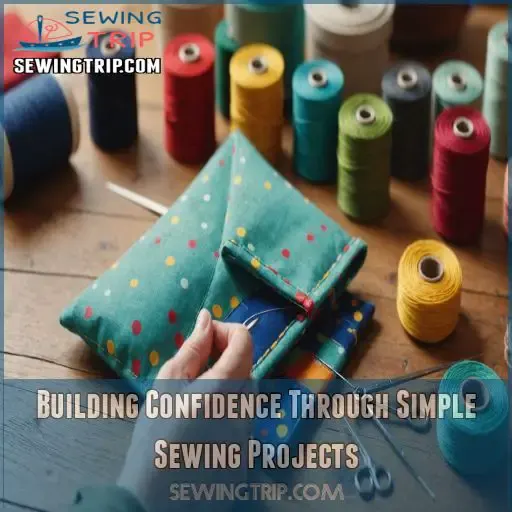This site is supported by our readers. We may earn a commission, at no cost to you, if you purchase through links.
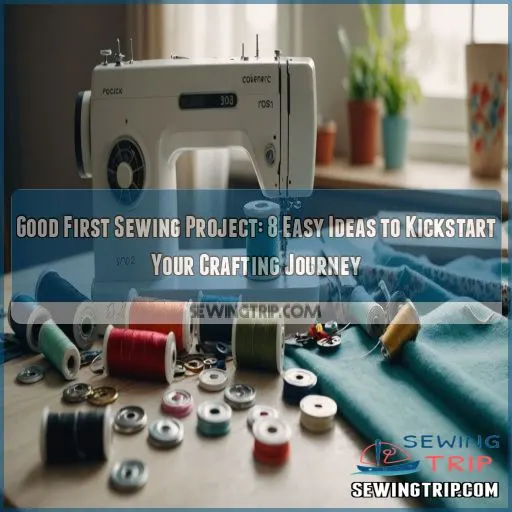 Wondering what’s a good first sewing project? You’re in luck! A simple pillowcase or tote bag is perfect for kickstarting your crafting journey. These beginner-friendly projects let you practice essential skills like straight stitching and seam finishing without getting tangled up in complexity.
Wondering what’s a good first sewing project? You’re in luck! A simple pillowcase or tote bag is perfect for kickstarting your crafting journey. These beginner-friendly projects let you practice essential skills like straight stitching and seam finishing without getting tangled up in complexity.
Plus, you’ll end up with something useful—talk about a win-win! Cotton fabrics are your best friend here, forgiving of rookie mistakes and easy to handle.
Table Of Contents
- Key Takeaways
- Simple Sewing Projects for Absolute Beginners
- Essential Skills to Master in Your First Project
- Choosing the Right Fabric for Beginner Projects
- Tools and Supplies Needed for First-time Sewers
- Step-by-step Guide to Sewing a Simple Project
- Common Mistakes to Avoid in First Sewing Projects
- Tips for Successful Completion of Your First Project
- Building Confidence Through Simple Sewing Projects
- Frequently Asked Questions (FAQs)
- Conclusion
Key Takeaways
- You’re in luck. Simple projects like pillowcases or tote bags are perfect for beginners. They’ll help you practice essential skills without getting tangled up in complexity – it’s like learning to walk before you run in the sewing world.
- Don’t sweat the fancy fabrics just yet. Stick with cotton or cotton blends for your first project. They’re forgiving of rookie mistakes and easy to handle, like training wheels for your sewing machine.
- Remember, slow and steady wins the race. Take your time, practice on scrap fabric, and don’t be afraid to ask for help. Every expert was once a beginner, so embrace the learning process – you’re stitching your way to success.
- Keep your toolkit simple to start. A reliable sewing machine, fabric scissors, and pins are your new best friends. Think of them as your sewing superhero squad, ready to help you tackle any project that comes your way.
Simple Sewing Projects for Absolute Beginners
Ready to start your sewing journey but not sure where to begin?
These eight simple projects are perfect for absolute beginners,
offering a fun and approachable way to learn essential sewing skills without the pressure of tackling complex designs.
Pillowcases and Cushion Covers
Pillowcases and cushion covers are your ticket to sewing success, learning how to make cushion covers. Let’s get crafting!
Drawstring Bags
Drawstring bags are a breeze to make and perfect for organizing your stuff.
Fabric Coasters
Fabric coasters are perfect for beginners. Whip up these cute minis with ease:
- Simple shapes
- Fun patterns
- Endless customization
- Great gift ideas
Pincushions
Pincushions are fun and practical. You’ll love making these cute sewing companions!
Tote Bags
Tote bags are your ticket to sewing success, learn how to make one. You’ll love making these versatile carriers!
- Strut your stuff with a custom-made shopping companion
- Feel the pride of crafting something both beautiful and useful
- Explore your creativity with endless design possibilities
- Experience the thrill of turning fabric into functional art
- Join the eco-friendly revolution with your reusable masterpiece
Scarves and Infinity Scarves
Next up, you’ll love creating scarves – they’re perfect for cozying up your wardrobe!
Headbands and Hair Accessories
You’ve mastered scarves; now let’s jazz up your locks with stylish headbands!
Simple Pot Holders
Simple pot holders are a perfect next step in your sewing adventure. Let’s make some!
To create a pot holder, you’ll need to:
- Pick heat-resistant fabrics
- Cut squares and layer them
- Quilt with decorative stitches
- Bind edges for a polished look
Essential Skills to Master in Your First Project
Now that you’ve got some project ideas, let’s tackle the skills you’ll need to bring them to life.
Threading your machine might seem like rocket science at first, but trust me, you’ll be doing it with your eyes closed in no time.
Straight stitching is your bread and butter – it’s the foundation of nearly every project.
Seam finishing is like putting the cherry on top of your sewing sundae.
Pressing as you go keeps everything neat and tidy, while pinning is your secret weapon for keeping fabrics in line.
Choosing the Right Fabric for Beginner Projects
Choosing the right fabric can make or break your first sewing project, so let’s pick a winner for your debut creation, checking out this guide to fabric selection.
We’ll explore some beginner-friendly fabrics that’ll set you up for success and have you stitching like a pro in no time.
Cotton and Cotton Blends
- Easy to handle
- Forgiving of mistakes
- Comes in various weights
- Perfect for practicing stitches
Felt and Fleece
Moving on from cotton, let’s explore felt and fleece – two fabrics that’ll make your life easier.
Lightweight Denim
Diving into lightweight denim? You’ll love its versatility for beginner-friendly projects like tote bags or placemats.
Quilting Cotton
Quilting cotton’s your new best friend! It’s sturdy, easy to handle, and comes in countless fun patterns.
Linen
Linen’s a classic choice for beginners. It’s easy to work with and has a lovely, natural texture.
Avoiding Slippery or Stretchy Fabrics
While linen’s lovely, steer clear of slippery or stretchy fabrics for now. They’re tricky to control!
Importance of Fabric Weight and Texture
Fabric weight and texture can make or break your project. Choose wisely for sewing success!
Tools and Supplies Needed for First-time Sewers
Ready to start your first sewing project? Let’s gear up with the essentials! You don’t need a treasure chest full of tools to start your crafting journey. A reliable sewing machine is your new best friend, ready to stitch your dreams into reality. Fabric scissors will be your trusty sidekick, slicing through material like a hot knife through butter. Don’t forget pins they’re the unsung heroes that’ll keep your fabric in line.
Here are three must-haves for your sewing toolkit:
- Measuring tape: Your secret weapon for perfect fits when taking body measurements
- Thread: The lifeline of your creations
- Seam ripper: Your "oops" eraser for those inevitable mistakes
With these tools at your fingertips, you’ll be stitching up a storm in no time!
Step-by-step Guide to Sewing a Simple Project
Ready to turn your sewing dreams into reality?
Let’s walk through the essential steps to create your first simple project,
from prepping your fabric to adding those finishing touches that’ll make your creation shine.
Preparing Your Fabric
You’ve got your tools, so let’s get your fabric ready for sewing!
Cutting and Pinning
Now that your fabric’s prepped, let’s tackle the next step: cutting and pinning.
Threading the Machine
Threading your machine might seem intimidating, but it’s simpler than untangling holiday lights!
Sewing Straight Lines
While sewing straight lines may seem tricky, it’s a breeze with these tips:
- Eyes on the fabric guide
- Steady hand pressure
- Even foot pedal control
Pivoting and Turning Corners
You’ve mastered straight lines. Let’s tackle corners! It’s easier than you think.
Finishing Seams
Finishing seams gives your project a polished look. Try these techniques:
- Serging
- Overcasting
- Zigzag stitch
Pressing and Ironing
Smooth out those wrinkles! Pressing gives your project a polished, professional look. Let’s iron.
Here are some tools that can help you press your project:
| Tool | Use |
|---|---|
| Ironing board | Stable surface for work |
| Steam iron | Removes stubborn creases |
| Pressing cloth | Protects delicate fabrics |
| Tailor’s ham | Shapes curved seams |
Adding Final Touches
Now that you’ve ironed everything flat, let’s add some pizzazz to your creation!
Common Mistakes to Avoid in First Sewing Projects
Rookie mistakes can trip up even the most enthusiastic beginner sewers. Don’t fret! We’ve all been there, fumbling with fabric and tangling threads. Let’s steer clear of some common pitfalls that might put a wrinkle in your sewing journey.
Incorrect seam allowances are like the secret sauce of a well-fitted project.
Skipping back stitching? That’s a no-no unless you want your hard work unraveling faster than a poorly told joke.
Remember to press as you go; it’s not just for wrinkled shirts!
Knotting thread might seem like a good idea, but it’ll leave you in knots.
Choosing the wrong needle? It’s like bringing a spoon to a knife fight.
Keep these tips in mind, and you’ll be stitching up a storm in no time!
Tips for Successful Completion of Your First Project
You’ve got your fabric, your machine’s threaded, and you’re ready to start your first sewing project – how exciting!
Let’s explore some tried-and-true tips that’ll help you sail through your inaugural sewing adventure with confidence and a smile on your face.
Practicing on Scrap Fabric
Before diving into your project, grab some fabric scraps and experiment. It’s your chance to make mistakes without consequences. Think of it as a sewing playground!
Taking It Slow and Steady
When starting your first sewing project, remember: slow and steady wins the race. Take your time and enjoy the process:
- Breathe deeply
- Focus intently
- Celebrate small victories
Using the Right Needle and Thread
You’ve got the speed down, now let’s pair up the perfect needle and thread. It’s like matchmaking for your fabric!
Maintaining Proper Tension
Proper tension’s the secret sauce for smooth stitches. Check your bobbin winding and match thread type to needle size and fabric weight. It’ll make all the difference!
Asking for Help When Needed
Don’t be afraid to reach out for help! Sewing can be tricky, but there’s a whole community ready to support you.
There are many ways to get help with sewing:
- A seasoned seamstress patiently guiding your hands through a tricky seam
- An online forum buzzing with friendly advice and shared experiences
- A local sewing class filled with laughter and the hum of machines
Building Confidence Through Simple Sewing Projects
Starting your sewing journey can feel like diving into the deep end, but don’t let that deter you! Start with simple projects that spark joy and build your skills step by step. Remember, every expert was once a beginner too. Choose projects that excite you, whether it’s a cute tote bag or a cozy pillowcase.
As you complete each one, you’ll gain confidence and develop your unique style. Celebrate small victories, like sewing your first straight line or mastering a new stitch. Don’t be afraid to make mistakes – they’re part of the learning process.
Share your creations with friends or join online sewing communities for support and inspiration. Before you know it, you’ll be tackling more complex projects with ease and expressing your creativity through fabric and thread.
Frequently Asked Questions (FAQs)
What is the best beginner sewing project?
Did you know 75% of beginners start with drawstring bags?
They’re your perfect first project.
You’ll master straight stitching, work with different fabrics, and end up with a useful item.
It’s like hitting the sewing jackpot!
What is the first thing I should sew?
For your first sewing project, try a simple drawstring bag.
It’s quick, easy, and you’ll get to practice straight stitching.
Plus, you’ll end up with a useful item you can show off to friends and family!
What should a beginner learn in sewing?
You’ll want to master straight stitching, threading your machine, and basic seams.
Don’t forget about fabric prep and cutting skills.
Start with simple projects like pillowcases or tote bags to build confidence.
What is the easiest clothing to sew for beginners?
Start with elastic-waist skirts or simple pajama pants.
They’re forgiving and fun to make.
Whip up a cozy pair of PJs, and you’ll be strutting your stuff in no time.
It’s like riding a bike – practice makes perfect!
How long does it take to complete a beginner project?
Beginner projects typically take 1-3 hours, depending on your skill level and the complexity.
Don’t rush – it’s about learning and enjoying the process.
Can I sew without a machine for my first project?
Hand-sewing is a great way to dip your toes into the craft.
Simple projects like drawstring bags or small pillows are perfect for learning basic stitches, especially when you’re starting out with beginner sewing patterns.
It’s slower than machine sewing, but you’ll gain valuable skills.
What are some budget-friendly options for first sewing projects?
Did you know 78% of sewers start with zero-cost materials?
You’ve got options! Repurpose old clothes for tote bags, whip up fabric coasters from scrap pieces, or craft a no-sew fleece blanket.
You’ll be stitching up a storm in no time!
How do I know if my stitches are correct?
You’ll know your stitches are spot-on when they’re even, straight, and secure.
Check for consistent length and tension.
If they look like a tidy row of soldiers marching in line, you’re nailing it!
Keep practicing to perfect your technique.
Should I prewash fabric before starting my first project?
Shrinkage can turn your project into a pint-sized disaster!
Prewashing fabric is like giving it a test run.
It’ll prevent surprises and make sure your creation fits like a glove.
Plus, you’ll wash out any pesky chemicals.
Conclusion
From a bit of a challenge to a delightful hobby, your first sewing project is a gateway to endless creativity, and the Brother CS5055PRW is a great place to start.
Whether you choose a pillowcase or a tote bag, remember that perfection isn’t the goal—progress is.
As you ponder what’s a good first sewing project, embrace the learning process. Each stitch brings you closer to mastery.
So, thread that needle, fire up your machine, and get started! You’ll be amazed at how quickly your skills grow and how satisfying it’s to create something with your own two hands.

